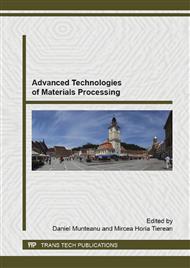[1]
B.H. Salman, H.A. Mohammed, A. Sh Kherbeet, Numerical and experimental investigation of heat transfer enhancement in a microtube using nanofluids. International Communications in Heat and Mass Transfer 59 (2014) 88-100.
DOI: 10.1016/j.icheatmasstransfer.2014.10.017
Google Scholar
[2]
A.A. Minea, Uncertainties in modeling thermal conductivity of laminar forced convection heat transfer with water alumina nanofluids. International Journal of Heat and Mass Transfer 68 (2014) 78-84.
DOI: 10.1016/j.ijheatmasstransfer.2013.09.018
Google Scholar
[3]
C. Kleinstreuer, F. Yu, Experimental and theoretical studies of nanofluid thermal conductivity enhancement: a review, Nanoscale Research Letters 161(2011) 1-6.
DOI: 10.1186/1556-276x-6-229
Google Scholar
[4]
W. Yu, D.M. France, E.V. Timofeeva, D. Singh, J.L. Routbort, Thermophysical property-related comparison criteria for nanofluid heat transfer enhancement in turbulent flow, Applied Physics Letters 96 (2010) 1-3.
DOI: 10.1063/1.3435487
Google Scholar
[5]
W. Yu, D.M. France, E.V. Timofeeva, D. Singh, J.L. Routbort, Comparative review of turbulent heat transfer of nanofluids, International Journal of Heat and Mass Transfer 55 (2012) 5380–5396.
DOI: 10.1016/j.ijheatmasstransfer.2012.06.034
Google Scholar
[6]
R.S. Vajjha, D.K. Das, A review and analysis on influence of temperature and concentration of nanofluids on thermophysical properties, heat transfer and pumping power, International Journal of Heat and Mass Transfer 55 (2012) 4063–4078.
DOI: 10.1016/j.ijheatmasstransfer.2012.03.048
Google Scholar
[7]
W. Yu, D.M. France, E.V. Timofeeva, D. Singh, J.L. Routbort, Comparative review of turbulent heat transfer of nanofluids, International Journal of Heat and Mass Transfer 55 (2012) 5380–5396.
DOI: 10.1016/j.ijheatmasstransfer.2012.06.034
Google Scholar
[8]
R.S. Vajjha, D.K. Das, Measurements of Thermophysical Properties of Nanofluids and Computation of Heat Transfer Characteristics, LAP Lambert Academic Publishing, London, (2010).
Google Scholar
[9]
V. Bianco, O. Manca, S. Nardini, Performance analysis of turbulent convection heat transfer of Al2O3 water-nanofluid in circular tubes at constant wall temperature, Energy 3 (2014) 1-11.
DOI: 10.1016/j.energy.2014.09.025
Google Scholar
[10]
J. Sarkar, A critical review on convective heat transfer correlations of nanofluids, Renew. Sustain. Energy Rev. 15 (2011) 3271–3277.
DOI: 10.1016/j.rser.2011.04.025
Google Scholar
[11]
J. Buongiorno, Convective transport in nanofluids, Journal of Heat Transfer 128 (2006) 240–250.
DOI: 10.1115/1.2150834
Google Scholar
[12]
R.L. Hamilton, O.K. Crosser, Thermal conductivity of heterogeneous two component system, I and EC Fundamentals 1 (1962) 187–191.
Google Scholar
[13]
X. Zhang, H. Gu, M. Fujii, Effective thermal conductivity and thermal diffusivity of nanofluids containing spherical and cylindrical nanoparticles, Journal of Applied Physics 100 (2006) 1–5.
DOI: 10.1063/1.2259789
Google Scholar
[14]
H. Brinkman, The viscosity of concentrated suspensions and solutions, J. Chem. Phys. 20 (1952) 571.
Google Scholar
[15]
C.H. Li, G.P. Peterson. Experimental investigation of temperature and volume fraction variations on the effective thermal conductivity of nanoparticle suspensions (nanofluids). Journal of Applied Physics 99 (2006) 084314.
DOI: 10.1063/1.2191571
Google Scholar
[16]
H.E. Patel, T. Sundararajan, S.K. Das, An experimental investigation into the thermal conductivity enhancement in oxide and metallic nanofluids. Journal of Nanoparticle Research 12 (2010) 1015–1031.
DOI: 10.1007/s11051-009-9658-2
Google Scholar
[17]
A.A. Minea, Simulation of Nanofluids Turbulent Forced Convection at High Reynolds Number: A Comparison Study of Thermophysical Properties Influence on Heat Transfer Enhancement, Flow Turbulence Combust (2015) 94 555–575.
DOI: 10.1007/s10494-014-9590-0
Google Scholar
[18]
Y.M. Xuan, Q. Li, Investigation on convective heat transfer and flow features of nanofluids. Journal of Heat Transfer 125 (2003) 151-155.
DOI: 10.1115/1.1532008
Google Scholar


